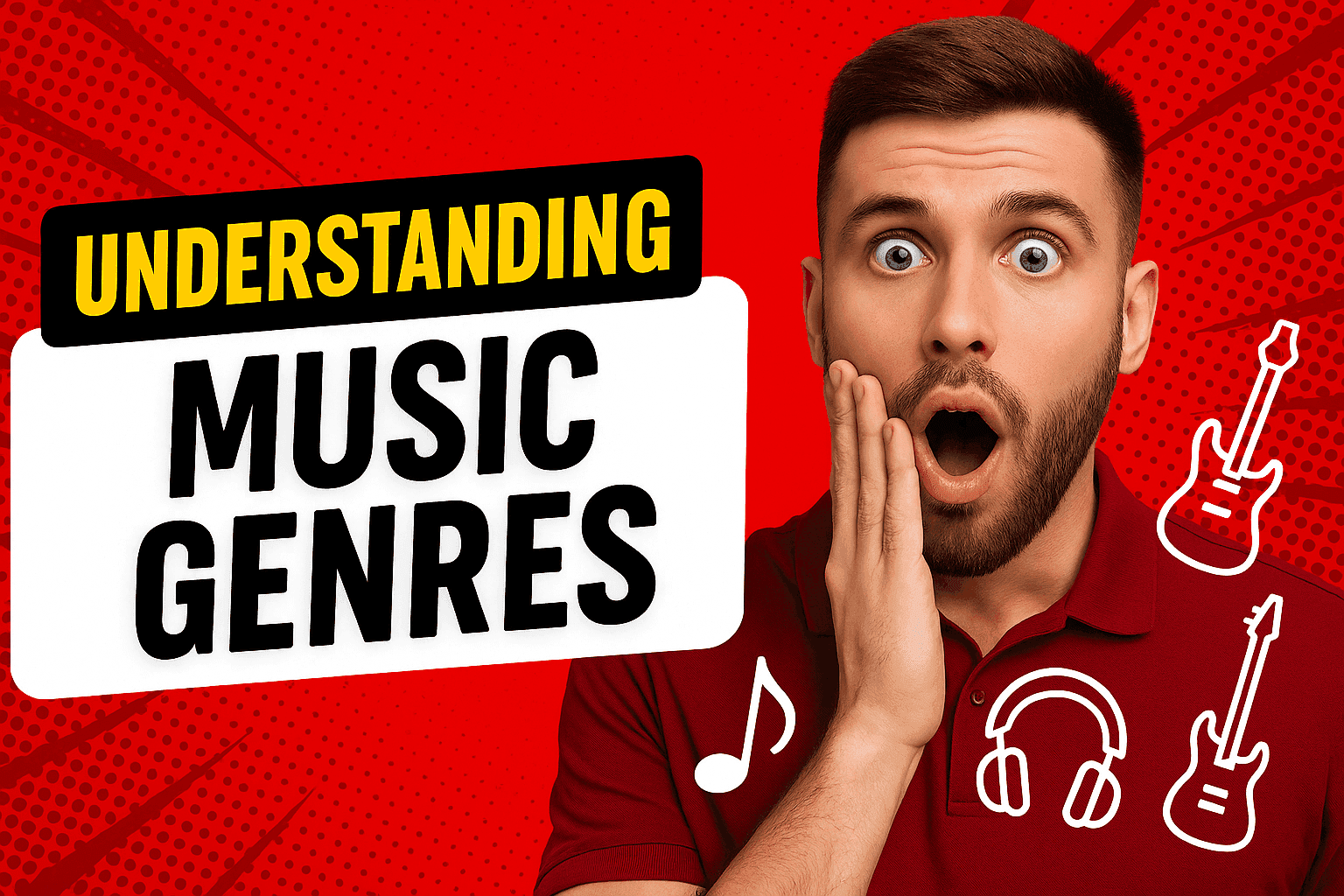
Art Gharana — 9 Mins read
Understanding Music Genres: Comprehensive Guide to Explore Musical Styles
Music
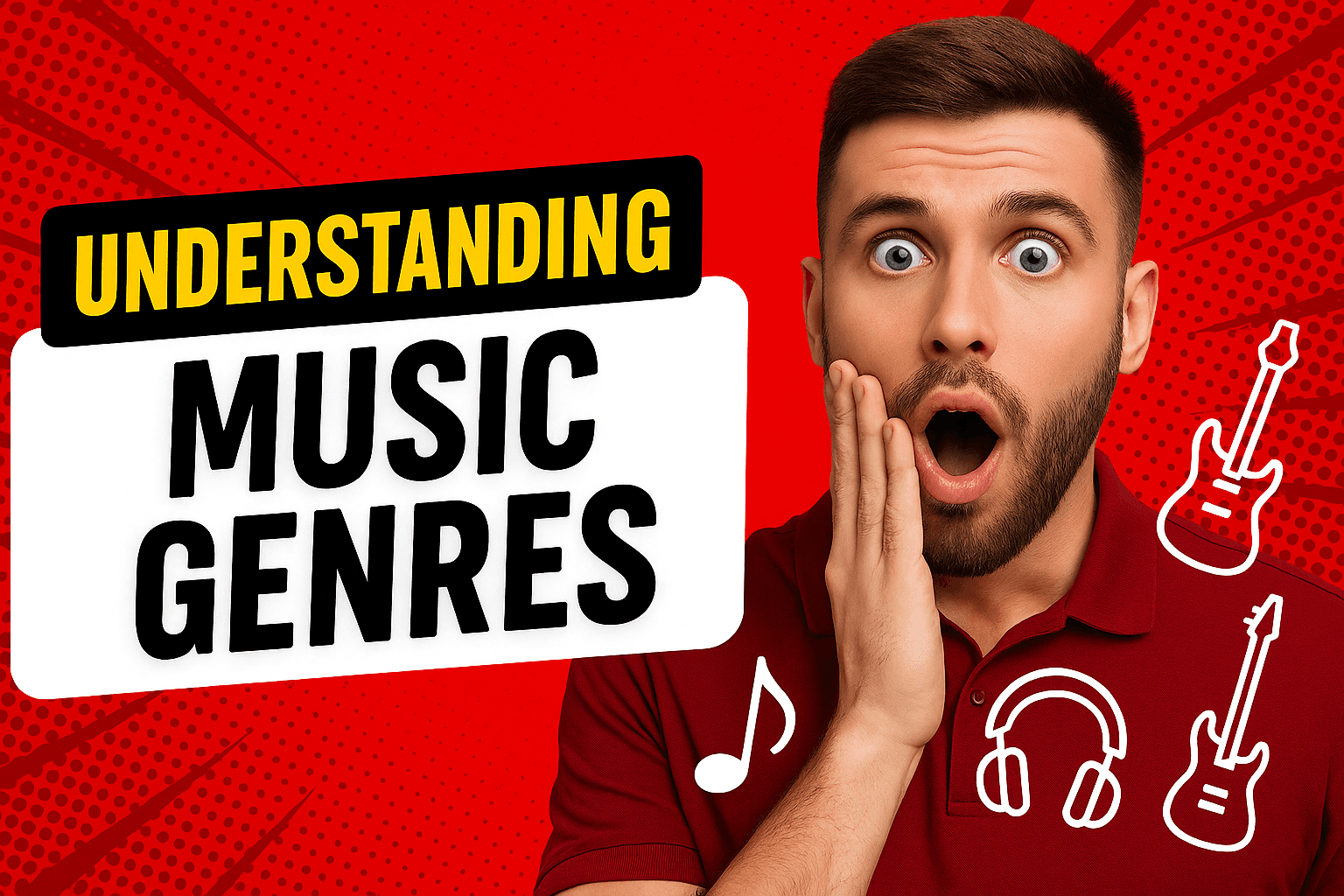 Music is a universal language that reflects culture, emotion, and creativity. Understanding music genres helps you identify different musical styles and subgenres, appreciate global music genres, and learn music more effectively. From pop music to Hindustani classical music, each genre tells a story through rhythm, melody, and instrumentation. Whether you are a beginner or an advanced student, knowing the differences between genres can shape your musical journey.
Music is a universal language that reflects culture, emotion, and creativity. Understanding music genres helps you identify different musical styles and subgenres, appreciate global music genres, and learn music more effectively. From pop music to Hindustani classical music, each genre tells a story through rhythm, melody, and instrumentation. Whether you are a beginner or an advanced student, knowing the differences between genres can shape your musical journey.
Music genres also provide a roadmap for music learning and music teaching. They help students focus on the structure of music, beat, harmony, tempo, and arrangement. Modern tools like online music classes and online music learning platforms give access to genre-based learning and personalized music learning, allowing anyone to explore fusion genres, traditional music styles, and contemporary music styles from anywhere in the world.
 A music genre is a category that classifies songs or compositions based on shared characteristics such as rhythm, melody, instrumentation, harmony, and vocal style. These categories guide music students and listeners in identifying styles, from rock music to R&B music. Popular music genres like pop music, hip hop music, and jazz music define cultural moments, while traditional music styles preserve heritage and history.
A music genre is a category that classifies songs or compositions based on shared characteristics such as rhythm, melody, instrumentation, harmony, and vocal style. These categories guide music students and listeners in identifying styles, from rock music to R&B music. Popular music genres like pop music, hip hop music, and jazz music define cultural moments, while traditional music styles preserve heritage and history.
Genres also reflect emotions, culture, and innovation. They make it easier to learn music online in a structured way through genre-specific learning and music courses. For example, understanding the groove and beat in electronic dance music (EDM) is different from mastering Indian classical music, where raga and tala define the melody and rhythm.
The concept of music genres has existed for centuries. Classical European traditions categorized music into symphonies, operas, and chamber music, while African and Indian cultures used rhythm and raga to define their styles. Over time, modern music genres emerged, influenced by migration, technology, and global communication.
Cross-cultural music influences shaped genres like jazz, which blends African rhythms with European harmonies. Fusion music now combines elements of Bollywood music, rock music, and classical music, showing how genres evolve with time and technology.
Each genre has unique elements. Rhythm and tempo define hip hop music and trap music, while melody and harmony are crucial in classical music and Carnatic classical music. Instrumentation sets pop music apart from metal music, and cultural context gives meaning to folk music and world music.
For instance, R&B music emphasizes vocal style and groove, while jazz music relies heavily on improvisation and musical theory. Understanding these elements allows music students to appreciate and perform contemporary music styles or genre-specific learning effectively.
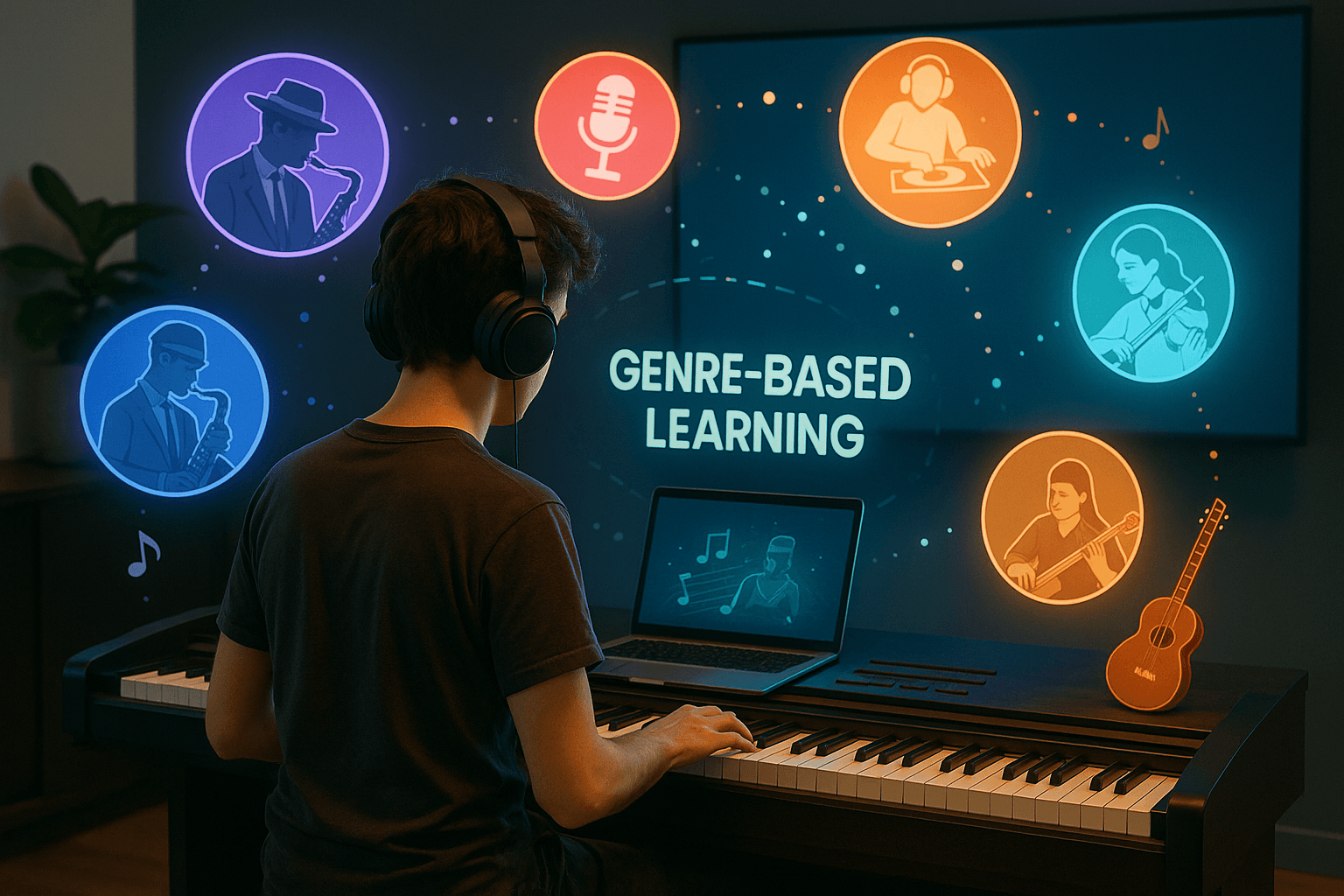 The Role of Genres in Music Learning and Appreciation
Knowing music genres helps music learners explore musical styles and subgenres efficiently. It allows them to recognize structures like scales, chords, and notation. Students practicing online music learning can follow genre-based training that focuses on rhythm, melody, and arrangement specific to global music genres.
The Role of Genres in Music Learning and Appreciation
Knowing music genres helps music learners explore musical styles and subgenres efficiently. It allows them to recognize structures like scales, chords, and notation. Students practicing online music learning can follow genre-based training that focuses on rhythm, melody, and arrangement specific to global music genres.
Genres also enhance listening and appreciation. For example, recognizing the tempo in electronic dance music (EDM) versus the tala in Hindustani classical music enriches the understanding of musical styles and inspires creativity in composition and improvisation.
Genres influence how musicians express themselves. Alternative rock bands often experiment with lo-fi hip hop elements, while Bollywood music blends film music, devotional music, and fusion music. Learning these differences allows students to craft their own signature style.
A clear understanding of genre differences also helps performers communicate effectively with audiences. Musicians trained in genre-specific learning can switch between jazz music, rock music, and R&B music, creating diverse musical experiences.
For musicians, knowing genres determines choice of instrumentation, composition, and performance style. Country music relies on acoustic storytelling, while metal music emphasizes heavy guitar riffs and tempo changes. Online music classes provide opportunities for practical music training, giving students exposure to popular music genres and world music styles.
Genre-based learning ensures students grasp music theory, beat, and arrangement principles. This structured approach helps develop musical skills in both traditional music styles and modern music genres.

A genre is unique because of its combination of rhythm, melody, vocal style, and cultural influence. Blues music features emotional expression and improvisation, whereas pop music is defined by catchy melodies and structured composition. Understanding genre differences helps students navigate mainstream music genres versus fusion genres.
Sub-genres blend elements of multiple genres. Indie music often mixes alternative rock with lo-fi hip hop, while pop-rock combines catchy melodies with guitar-driven arrangements. This distinction helps students focus on genre-based training and personalized music learning for specific musical styles and subgenres.
Style is the individual interpretation within a genre. A classical music performance may differ in tone, improvisation, and instrumentation, even if it belongs to the same genre. Genre-specific learning allows students to appreciate these nuances in music theory, arrangement, and composition.
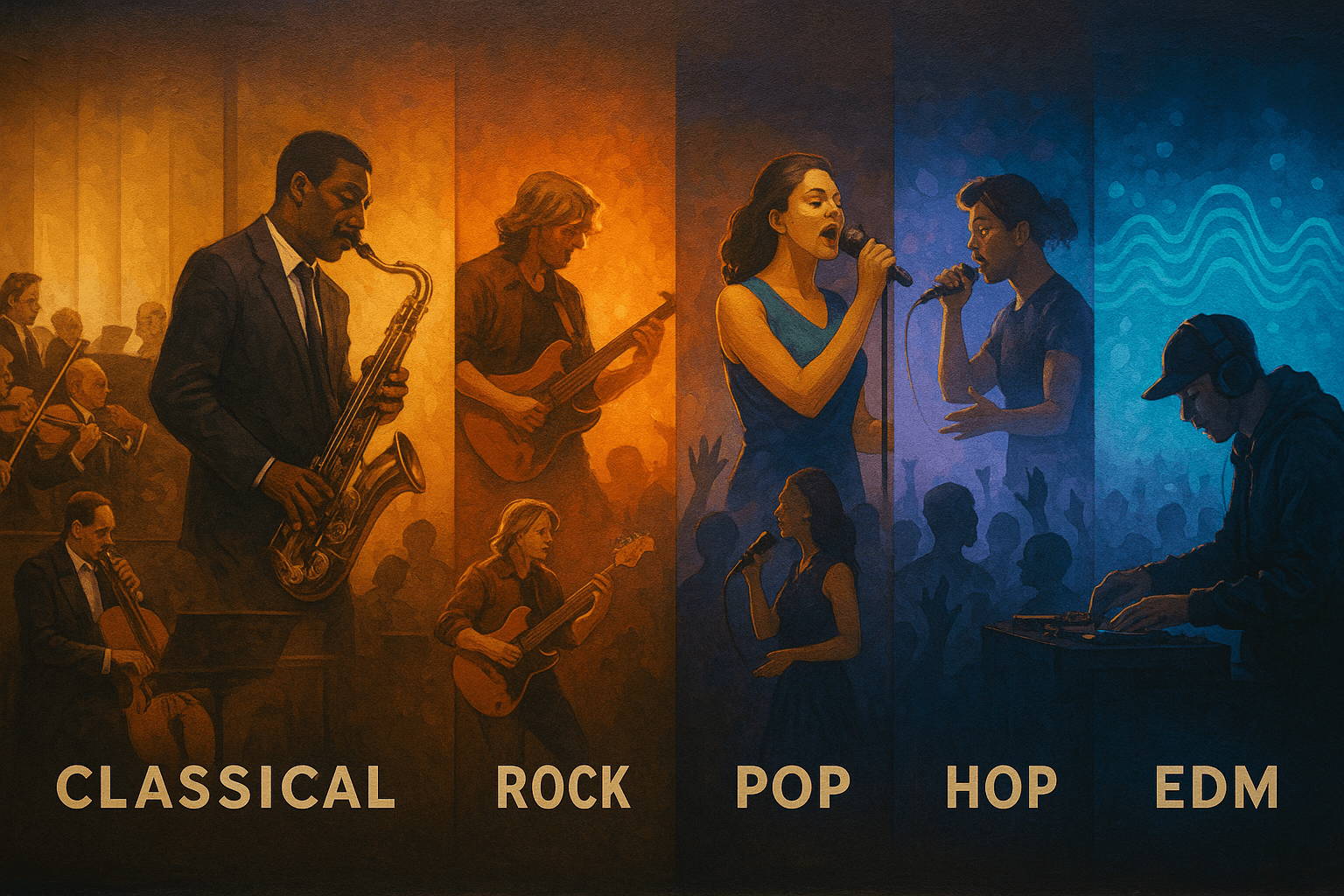
Music genres have deep roots. Classical music and Indian classical music laid the foundation for structured composition and symphony. Early folk music preserved cultural stories, while blues music expressed social struggles. These traditions influenced modern music genres globally.
Global migration and technology led to fusion music. Jazz fused African rhythms with European harmony. Reggae music and R&B music evolved through cultural exchange. Cross-cultural music influences created unique sounds, such as Bollywood music blending film music with fusion music.
Streaming platforms and online music classes transformed music learning and genre exploration. Students can now learn trap music, electronic dance music (EDM), or lo-fi hip hop from home. Digital tools support genre-based learning, music theory, and practical exercises in rhythm, tempo, and composition.

Pop music is widely accessible, featuring catchy melodies, simple chords, and rhythmic beats. It dominates charts and mainstream music genres, appealing to audiences worldwide. Online courses allow learners to master pop music with practical music training and genre-specific learning.
Rock music features electric guitars, strong rhythm, and energetic vocals. Subgenres like alternative rock and metal music showcase diverse musical styles. Students can learn techniques like improvisation, arrangement, and groove through structured music curriculum.
Hip hop music emphasizes rhythm, rap, and storytelling. Subgenres include trap music and lo-fi hip hop, each with unique beats and vocal style. Learning online allows students to practice composition, beat, and melody in genre-specific sessions.
Jazz music focuses on improvisation, swing, and complex chord progressions. It blends African rhythms with European harmonies. Online learners can explore notation, scales, and instrumentation to master jazz theory and practice.
Classical music forms the backbone of music education, emphasizing symphony, harmony, tempo, and structure. Both Western classical music and Indian classical music involve meticulous notation and composition study.
Country music tells stories through simple melody, acoustic instruments, and heartfelt lyrics. Students can explore musical styles and subgenres like folk music and traditional music styles to enhance performance skills.
Electronic dance music (EDM) uses synthesizers, loops, and digital beats to energize listeners. Rhythm, tempo, and arrangement are critical. Online music learning helps students master genre-specific training for EDM production.
R&B music and soul music focus on emotional expression, groove, and vocal style. Learning music theory, composition, and improvisation enhances performance and appreciation.
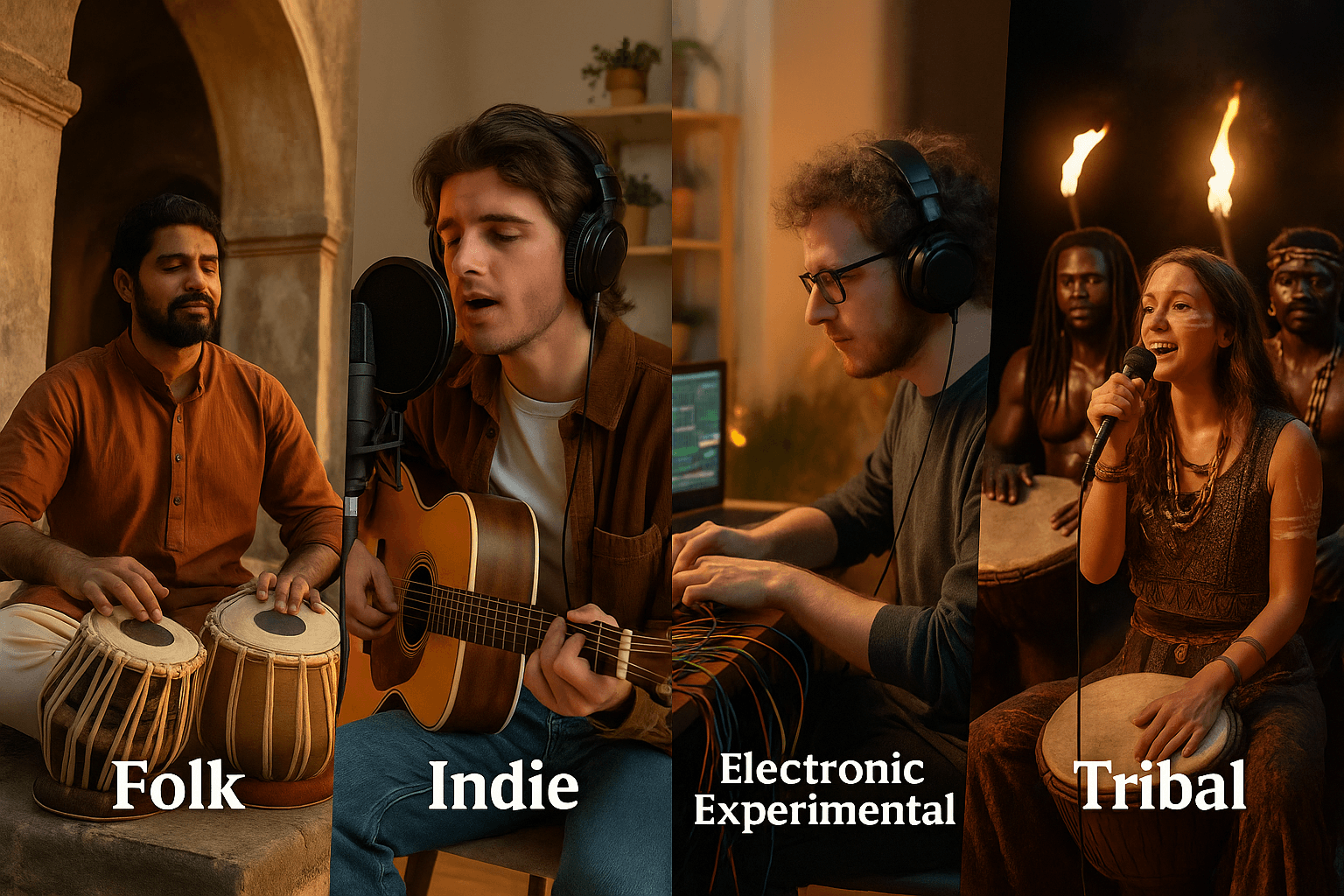
World music includes traditional rhythms, instruments, and cultural storytelling from around the globe. Students explore global music genres, understanding cross-cultural music influences and fusion music techniques.
Indie music, alternative rock, and fusion music push musical boundaries. Online learning supports genre-based training, exploring unconventional composition, melody, and instrumentation.
Folk music and traditional music styles preserve cultural identity through narrative songs and acoustic instruments. Learning these genres helps students understand the roots of modern music genres and musical styles and subgenres.

Hindustani classical music and Carnatic classical music focus on raga, tala, and improvisation. They are central to Indian classical music education, providing a deep understanding of structure of music and melody.
Bollywood music blends film music, fusion music, and Indian pop trends. Students can explore melody, instrumentation, and rhythm in genre-based learning courses.
India’s folk music reflects regional stories and traditions. Learning devotional music, Ghazals, and tribal tunes gives insight into traditional music styles and cultural roots.
Fusion music combines Indian classical with rock music, jazz music, or electronic dance music (EDM). Students benefit from practical music training and genre-specific learning to explore these innovative styles.

Institutes like Art Gharana offer structured music courses focused on learning music styles. Genre-based training allows students to study classical music, pop music, hip hop music, and fusion music efficiently.
Students practice beat, scales, chords, vocal style, and improvisation to internalize each genre. Online music learning enables access to genre-specific learning, enhancing personalized music learning experiences.
Online platforms allow exploration of global music genres, modern music genres, and traditional music styles. Students develop music theory, composition, and practical music training skills without geographic constraints.
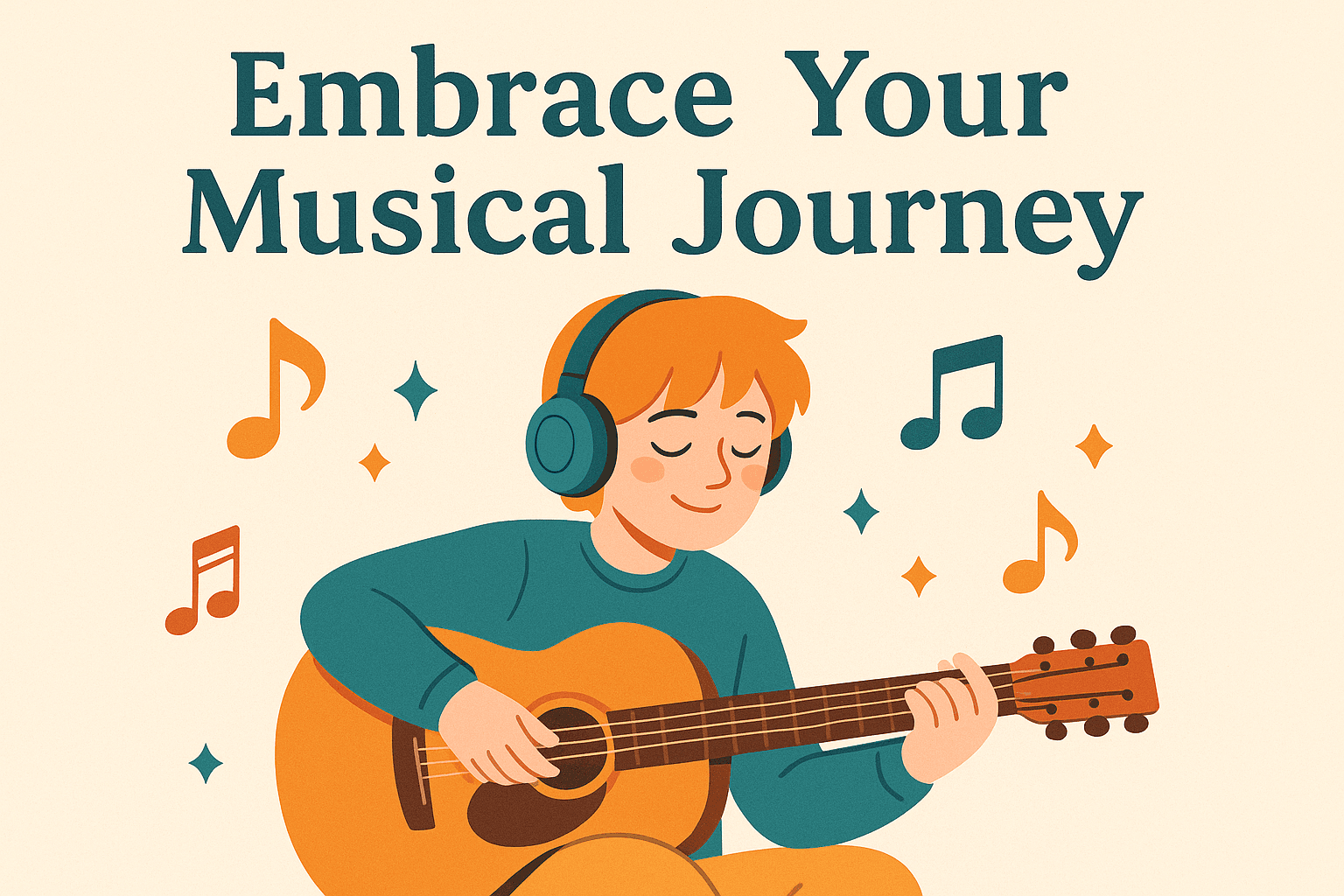
Active listening helps identify rhythm, tempo, and arrangement patterns in popular music genres. Experimenting with playlists exposes learners to fusion genres, world music, and alternative rock.
Hands-on practice in pop music, jazz music, hip hop music, or Indian classical music strengthens understanding of musical styles and subgenres and improves instrumentation skills.
Online music classes and communities allow students to access genre-based training, practical music training, and personalized music learning. Platforms like Artium Academy help learners explore multiple genres efficiently.
Main genres include pop music, rock music, hip hop music, jazz music, classical music, country music, R&B music, electronic dance music (EDM), folk music, and world music.
There are hundreds of modern music genres globally. Fusion genres and cross-cultural music influences continue to create new styles.
Globally, pop music, hip hop music, electronic dance music (EDM), and rock music dominate streaming and charts.
Genres guide music learning, composition, and musical expression. They help listeners understand structure of music, tempo, and instrumentation differences.
Choose a genre that matches your interest and learning goals. Beginners often start with pop music or rock music for simplicity and accessibility.
Yes. Online music classes allow students to explore hip hop music, jazz music, Bollywood music, Indian classical music, or fusion music from home.
Experimenting across global music genres helps learners discover personal preferences and signature sounds. Combining rhythm, melody, instrumentation, and vocal style develops individuality.
Mixing fusion music, pop music, and world music elements encourages creativity. Students can create modern music genres while maintaining roots in traditional music styles.
Understanding music genres is essential for every music student or enthusiast. From classical music to trap music, each genre enriches knowledge, creativity, and performance. Exploring global music genres, practicing genre-specific learning, and engaging in online music learning opens doors to endless musical possibilities. Music is a journey, and genres are your guide to discovering your unique sound.